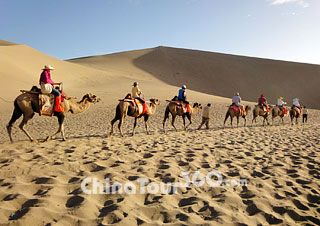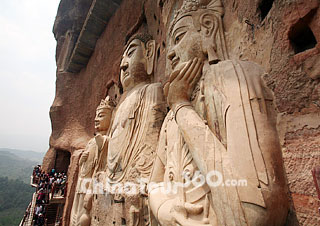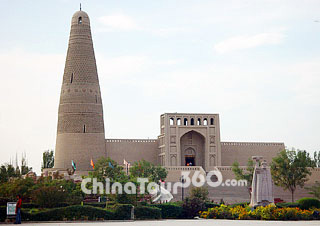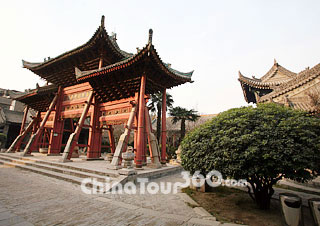 Camel Tour in Dunhuang
Camel Tour in Dunhuang Maiji Mountain, Gansu
Maiji Mountain, Gansu Local Snacks in Urumqi Bazaar
Local Snacks in Urumqi Bazaar Sugong Tower, Xinjiang
Sugong Tower, Xinjiang The Great Mosque, Xian
The Great Mosque, Xian City Wall, Xian
City Wall, Xian
The trip usually starts from Xian, which is also the starting point of the ancient Silk Road. As the provincial capital of Shaanxi Province, Xian is a famous historical city of over 3,000 years old. Many historical attractions deserve your special attention: the Banpo Museum, the Terra Cotta Warriors, the Huaqing Hot Spring, the Bell Tower, the Big Wild Goose Pagoda, and the City Wall of the Ming Dynasty (1368 - 1644).
Leaving Shaanxi, your next stop will be Gansu Province. Being one of the birthplaces of the Chinese Nation and ancient Chinese culture, Gansu is believed to be the hometown of Fu Xishi, a
mythical god-king of ancient China. The major historical attractions in Gansu are the Maijishan Grottos, the Binglingsi Grottos, Jiayuguan of the Great Wall, the Laburang Monastery, and the Dunhuang Mogao Grottos. In addition to these historical attractions, Gansu is also famous for the unique landscapes created by its special location and geography including fascinating mountainous grassland, the Gobi deserts, the Loess Plateau, the Danxia Landform, plus glaciers and snowy mountains. (Photographs are not allowed in Dunhuang Grottos, and there are no lights in the grotto, so bring a flashlight to enjoy the colorful mural in the grottos)
![]() Ningxia
Ningxia
Ningxia province neighbors Gansu and Shaanxi Provinces. Relics can be found around Guyuan City including the Qin Great Wall of the Warring States Period (476 - 221 BC), the Xumishan Grottos, and the Saozhuling Grottos. Ningxia was within the territory of the Xixia Kingdom during the Song Dynasty (960 - 1279), therefore, many constructions and cultural relics of the Xixia Kingdom can be found here. The most famous is the Imperial Mausoleum of the Xixia Kingdom, which is known as 'the Pyramid of China'. In addition to the mausoleum, there are many other attractions such as the Hai Pagoda, the Nanguan Mosque, and the Xiaogunzhongkou Mosque on the Helan Mountain. Also, Ningxia is the homeland of the Hui People (Chinese Muslims) in China, whose unique customs and life style are also worth enjoying.
![]() Qinghai
Qinghai
The southern section passed through northern Qinghai Province. As one of the five biggest grasslands in China and the source of the Yellow and the Yangtze Rivers, Qinghai is famous for its beautiful landscapes, including the largest inland saltwater lake - Qinghai Lake, the famous Birds Island, and the Xunhua Mengda Natural Reserve. In addition, Qinghai is famous for many cultural relics such as the Shrine of Tibetan Buddhism the Kumbum Monastery and the Qutan Temple, which was built in the palace construction style of the Ming Dynasty.
![]() Xinjiang Uygur Autonomous Region
Xinjiang Uygur Autonomous Region
Called Xiyu in ancient times, Xinjiang is located in the center of Eurasia. The road within Xinjiang was divided into three routes, spanning 2,000 km (1,243 miles). There are many relics along the routes in Urumqi, Turpan, Kashgar, Kuqa, Hotan and Tashkorghan. Xinjiang is also famous for the unique customs and life styles of its native peoples such as the Uygur, the Hui and the Kazak. Famous attractions in Xinjiang are Kalakul Lake, the Dawakun Desert, Tianchi Lake, and the Silk Road Museum. (Note: Xinjiang Time is 2 hours later than the Beijing Time)
![]() Climate
Climate
![]() The best time to explore the Silk Road is from May to October, when the average temperature is around 15 °C (59 °F) and the grasslands are green.
The best time to explore the Silk Road is from May to October, when the average temperature is around 15 °C (59 °F) and the grasslands are green.
![]() All of the destinations along the road are located in Northwestern China, having a temperate continental climate with strong sunshine and large temperature differences between day and night. Besides short-sleeves T-shirts, short pants and overcoats, visitors need to bring long-sleeves shirts, trousers or jeans, and overcoats or wind coats in summer. Don't forget the sun-block lotion, sunglasses, sun-hats, heatstroke preventive, sandals and mosquito bite healer.
All of the destinations along the road are located in Northwestern China, having a temperate continental climate with strong sunshine and large temperature differences between day and night. Besides short-sleeves T-shirts, short pants and overcoats, visitors need to bring long-sleeves shirts, trousers or jeans, and overcoats or wind coats in summer. Don't forget the sun-block lotion, sunglasses, sun-hats, heatstroke preventive, sandals and mosquito bite healer.
![]() It is very dry and dusty in these areas, so carry plenty of water at all times. For ladies, a big scarf is very useful when it is windy and dusty.
It is very dry and dusty in these areas, so carry plenty of water at all times. For ladies, a big scarf is very useful when it is windy and dusty.
![]() Transportation
Transportation
![]() The trip covers five provinces and areas in China, so the trip is very long. Visitors can transfer among the provinces by long-distance buses, by train or by air.
The trip covers five provinces and areas in China, so the trip is very long. Visitors can transfer among the provinces by long-distance buses, by train or by air.
![]() The route within each province is also very long, so a big rucksack is very necessary, in which you may carry some travel necessities like an umbrella, a water bottle, a flashlight, a towel and a map.
The route within each province is also very long, so a big rucksack is very necessary, in which you may carry some travel necessities like an umbrella, a water bottle, a flashlight, a towel and a map.
![]() Many attractions are far away from each other, especially in Xinjiang, so much of the time will be spent in travel buses. Visitors may need to take some carsickness pills.
Many attractions are far away from each other, especially in Xinjiang, so much of the time will be spent in travel buses. Visitors may need to take some carsickness pills.
![]() In Xinjiang, visitors can walk, ride a horse, or ride a camel at some of the attractions, so comfortable sneakers and trousers are very useful. A word of caution: a camel always stands up by straightening its hind legs first followed by the forelegs, so visitors should be careful when riding a camel.
In Xinjiang, visitors can walk, ride a horse, or ride a camel at some of the attractions, so comfortable sneakers and trousers are very useful. A word of caution: a camel always stands up by straightening its hind legs first followed by the forelegs, so visitors should be careful when riding a camel.
![]() Local Specialties
Local Specialties
![]() Shaanxi: cold noodles, and Mutton Soup with Steamed Bread are famous snacks in Xian. They can be enjoyed in the Muslem Street. In addition, if you come to Xian in September or October, don't forget to have a taste of Xian pomegranate.
Shaanxi: cold noodles, and Mutton Soup with Steamed Bread are famous snacks in Xian. They can be enjoyed in the Muslem Street. In addition, if you come to Xian in September or October, don't forget to have a taste of Xian pomegranate.
![]() Gansu: Lanzhou is the hometown of Lanzhou Beef Noodles, so don't miss the chance to taste these authentic beef noodles. Lanzhou Dried Lily Slice is also very famous and is good for moistening your lungs, removing phlegm and relieving cough. It is used in food dishes, soup or porridge.
Gansu: Lanzhou is the hometown of Lanzhou Beef Noodles, so don't miss the chance to taste these authentic beef noodles. Lanzhou Dried Lily Slice is also very famous and is good for moistening your lungs, removing phlegm and relieving cough. It is used in food dishes, soup or porridge.
![]() Ningxia: Matrimony Vine is a famous local specialty in Ningxia. Matrimony Vine is a kind of rare Chinese medicine that is very good for one's health. There are also other products made from Matrimony Vine such as Matrimony Vine juice, wine and candy. Ningxia woolen carpets are also well-known throughout the world. Many of the patterns on the carpets are traditional Chinese designs such as the white cranes and the dragons and phoenixes from old Chinese myths.
Ningxia: Matrimony Vine is a famous local specialty in Ningxia. Matrimony Vine is a kind of rare Chinese medicine that is very good for one's health. There are also other products made from Matrimony Vine such as Matrimony Vine juice, wine and candy. Ningxia woolen carpets are also well-known throughout the world. Many of the patterns on the carpets are traditional Chinese designs such as the white cranes and the dragons and phoenixes from old Chinese myths.
![]() Qinghai: Qinghai dairy products such as Qinghai yogurt and Qinghai cheese are very famous. In addition, Yushu City is famous for Tibetan Medicine and Health Care Products.
Qinghai: Qinghai dairy products such as Qinghai yogurt and Qinghai cheese are very famous. In addition, Yushu City is famous for Tibetan Medicine and Health Care Products.
![]() Xinjiang: Xinjiang Province is known as the hometown of fruit in China, and you can taste fresh fruit such as water melons, grapes and Hami melons at a very cheap price. But don't drink hot water after you eat the fruits, or you will be attacked by diarrhea. Except for the fresh fruits, Xinjiang is also famous for raisins, and nuts such as the walnut and Badamu (a kind of local nut).
Xinjiang: Xinjiang Province is known as the hometown of fruit in China, and you can taste fresh fruit such as water melons, grapes and Hami melons at a very cheap price. But don't drink hot water after you eat the fruits, or you will be attacked by diarrhea. Except for the fresh fruits, Xinjiang is also famous for raisins, and nuts such as the walnut and Badamu (a kind of local nut).
![]() Special Activities
Special Activities
![]() Each year, there are many tourism activities in Gansu Province, such as 'the Summer of Dunhuang', the Jiayuguan International Gliding Festival, and the Tianshui Fu Xi Cultural Festival.
Each year, there are many tourism activities in Gansu Province, such as 'the Summer of Dunhuang', the Jiayuguan International Gliding Festival, and the Tianshui Fu Xi Cultural Festival.
![]() In the mosques of Ningxia, the End of the Ramadan and the Corban Festival attracts many Muslims and visitors.
In the mosques of Ningxia, the End of the Ramadan and the Corban Festival attracts many Muslims and visitors.
![]() There are many minority groups in Xinjiang Province, and each of them have different life styles and customs. Visitors should respect the local customs. Many Xinjiang people are Muslim and pork is their taboo, so please do not take any pork products or talk publicly about pork when visiting a mosque.
There are many minority groups in Xinjiang Province, and each of them have different life styles and customs. Visitors should respect the local customs. Many Xinjiang people are Muslim and pork is their taboo, so please do not take any pork products or talk publicly about pork when visiting a mosque.
![]() Recommended Silk Road Itineraries:
Recommended Silk Road Itineraries:
Silk Road Tour: 14 Days to Beijing, Urumqi, Kasghar, Urumqi, Turpan, Dunhuang, Xian and Shanghai
Silk Road Adventure: 22 Days to Beijing, Urumqi, Korla, Kuqa, Aksu, Kashgar, Hetian, Minfeng, Korla, Turpan, Dunhuang, Xian and Shanghai
Silk Road In-depth: 20 Days to Beijing, Xian, Xining, Lanzhou, Xiahe, Lanzhou, Wuwei, Zhangye, Jiayuguan, Dunhuang, Turpan, Urumqi and Shanghai







